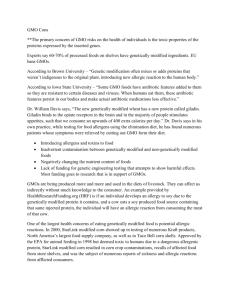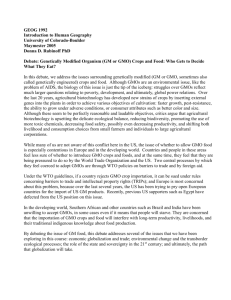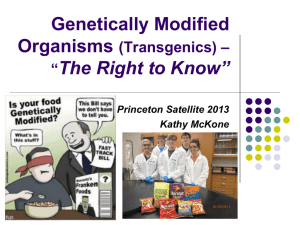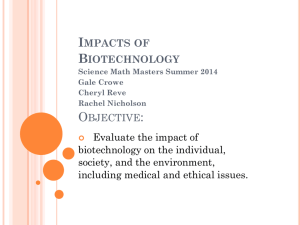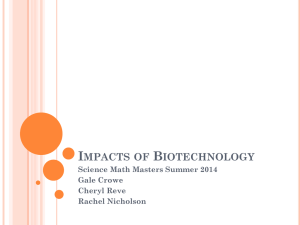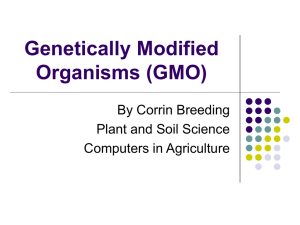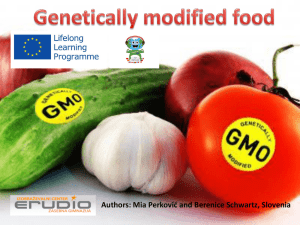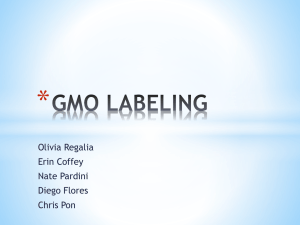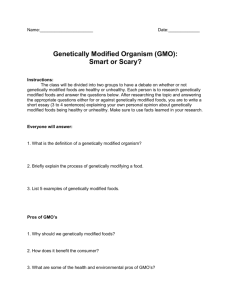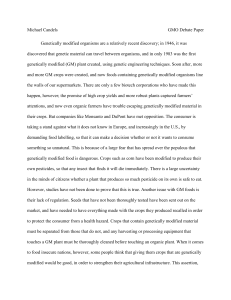Genetically Modified Crops
advertisement
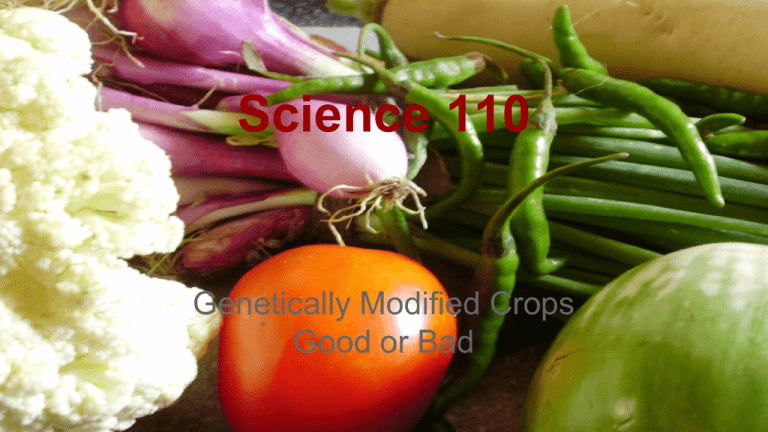
Science 110 Genetically Modified Crops Good or Bad What are GMOs ❖ Stands for Genetically Modified Organisms ❖ Organisms that have a particular gene inserted into their genetic makeup from another organism ❖ Used in Agriculture, Medicine, and Environmental Science Leading Producers of GM Crops ❖ U.S. ❖ China ❖ Argentina ❖ Brazil ❖ Canada ❖ Paraguay Which is not a GMO? Basic GMO Process ❖ Use the latest Molecular Biology Techniques ❖ Isolate the gene responsible for a desired trait ❖ Transfer the gene into a different plant Brief GMO Timeline ❖ 1935 Russian Scientist Andrei Belozersky isolates pure DNA. ❖ 1973 The idea for Man Made DNA comes from a grad student out of Stanford University Medical School. ❖ 1975 Asilomar Conference. Doctors and lawyers create guidelines for safe genetic DNA ❖ 1980 First patent on a living organism. A bacterium with an appetite for crude oil, used to clean up spills. ❖ 1994 The U.S. FDA approves the Flavr Savr Tomato for sale on the grocery store shelves. ❖ 1996 First Genetically Engineered insect resistant corn approved by USDA ❖ 1997 Insect resistant Bt cotton approved by USDA ❖ 1997 European Union Rules to label all GMO food products. ❖ 1999 100 million acres are planted worldwide using GMO seeds. ❖ 2010 Syngenta’s “stacked” corn variety is approved by USDA. It contains multiple GE traits as well as a resistance to pests. http://gmoinside.org/gmo-timeline-a-history-genetically-modified-foods/ http://www.nofamass.org/content/timeline-genetically-modified-food-us#.VGMLp8m9vyU Pros vs. Cons Pros Pros of genetically modified foods ❖ Better tasting food ➢ When foods are genetically modified, they can be enhanced in multiple ways. One way they can be modified is by enhancing flavor. for example, corn can be made sweeter by genetically modifying it. ❖ More nutritional benefits ➢ Another way that foods can be modified are through nutrients. Vitamins and minerals can be added through the genetic modification process to provide greater nutritive benefits to those who eat them. ❖ Crops have more durability in bad weather ➢ With modifications, crops can withstand extreme weather conditions and still maintain high quality. Pros Cont. ❖ ❖ ❖ ❖ Golden rice grown in the Philippines. Vitamin A deficiency is responsible for 500,000 cases of irreversible blindness and up to 2 million deaths each year. Golden Rice contains beta Carotene and vitamin A which regular rice does not about 1 cup of golden rice a day could provide half an adults vitamin A needs. golden rice is not yet available for consumers to purchase. Cons of GMOs Cons Cons of Genetically modified foods ❖ Altering evolution ➢ When plants are being genetically modified, they are being tampered with and taken out of their natural state. This could throw off natural selection and the entire process of evolution for those plants. ❖ Increase in allergic reactions ➢ Studies have shown that the consumption of GMO foods increases the risks of food-based allergies in people ❖ Harm to the environment ➢ The herbicides associated can harm birds, insects, marine ecosystems and soil organism. They can also pollute water resources and are unstable. ➢ GM crops are destroying the habitat for the Monarch Butterfly their population is down 50% in the U.S. Cons Cont. ❖ Government Oversight ➢ Most health and environmental risk are ignored by government safety assessments. (because of political reasons). ➢ An outstanding consensus of FDA’s own scientist was that GMOs can create unpredictable and hard to detect side effects. ➢ Does not require a single safety study, does not mandate labeling of GMOs. ❖ Unhealthy ➢ since GMOs were released in 1996 the percentage of Americans with three or more chronic illnesses went from 7% to 13%. ➢ food allergies have skyrocketed and disorders such as autism, reproductive disorders and digestive problems are on the rise. Side Effects on Animals ❖ Rats ➢ Both male and female were found to have mammy tumors. ➢ Showed to have difficulty breathing. ➢ Liver and kidney damage as early as four months ➢ 50% males and 70% females died prematurely. http://www.organicconsumers.org/articles/article_11361.cfm http://www.naturalnews.com/037249_gmo_study_cancer_tumors_organ_damage.html Side Effects on Humans ❖ Allergic Reactions ➢ GM Soy ■ In UK, soy allergies went up 50% soon after GM Soy was introduced ■ One person had a skin prick allergy to GM Soy but not to regular Soy ■ Contains an unexpected allergen-type protein not found in natural soy ➢ Bt Corn ■ Filipinos from five different villages got sick when a close Bt corn variety was pollinating ■ The gene that creates Bt toxin were to transfer it might turn our intenstinal flora into living pesticide producer http://www.organicconsumers.org/articles/article_11361.cfm Environmental Damage There are many risks involved in the use of GMO’s. Environmental damage is one of those risks. But, how do they affect the environment? ● Firstly, toxicity is a huge issue surrounding chemical pesticides and herbicides used commonly with GMO’s. ● GMOs may be toxic to non-target organisms such as bees and butterflies. ● Bees are hugely important in the pollination of crops, but are extremely endangered by the modern agricultural techniques used with GM foods. Environmental Damage cont. ● Monarch butterflies are specifically at risk from GMO maize plants. ● Birds are also at risk from pesticides. They act as biological control agents such as pollinators, like bees and butterflies. ● Secondly, Long term effects of GMO’s are NOT certain. ● Pests that are targeted by these agricultural methods can adapt to pesticides and herbicides. ● This means that it will not always be effective, but their toxic legacies will remain. Environmental damage cont. ● Finally, biodiversity is put at risk by GMOs. ● When GM crops are planted many heritage seeds are no longer used. ● Toxins released into the soil through the plants roots mean fewer soil bacteria, which are integral to healthy soil for plants to grow without the use of chemical fertilizers. Toxic residues are left in the soil of GM crops. ● Nutrients are not returned to the soil in mono crops and from GMO foods, meaning that soil is becoming dry and void of all nutrients, generally integral to the growing process. ● A cycle of dependence on GMO seeds and chemical fertilizers, pesticides, and herbicides is then created in order to grow a single crop. In addition to soil issues, the irrigation used to grow GM foods naturally carries all of these problems into water sources and into the air. This exposes different bacteria, insects, and animals to the same problems.
